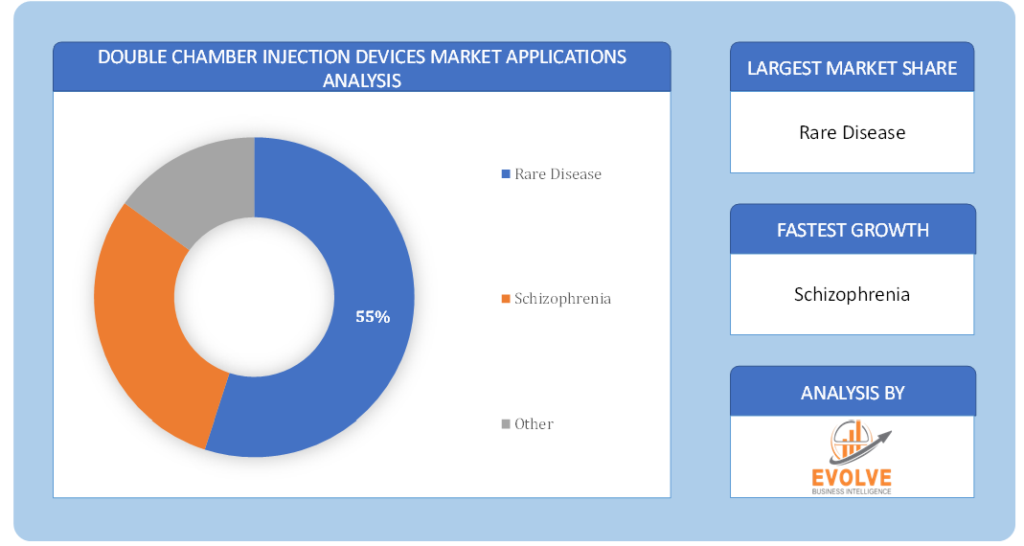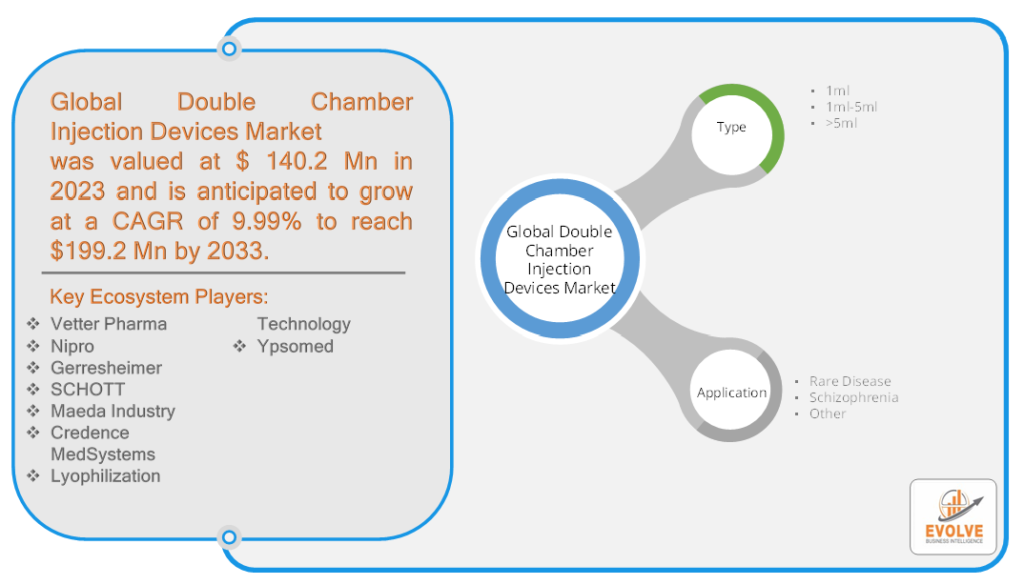Double Chamber Injection DevicesMarket Overview
The global Double Chamber Injection Devices Market Size is expected to reach USD 199.2 Million by 2033. The global Double Chamber Injection Devices industry accounted for USD 140.2 Million in 2023 and is expected to expand at a compound annual growth rate (CAGR) of 9.99% from 2023 to 2033. Double-chamber injection devices are medical devices that are designed to deliver two different drugs in a single injection. The device consists of two chambers, each filled with a different drug, that can be mixed prior to injection. Double-chamber injection devices are commonly used in the treatment of various medical conditions such as diabetes, cancer, and autoimmune diseases. These devices offer several benefits over traditional injections, including improved patient compliance, a reduced risk of medication errors, and increased convenience.
Global Double Chamber Injection Devices Market Synopsis
The COVID-19 pandemic has had a significant impact on the global healthcare industry, including the double chamber injection device market. The pandemic has led to disruptions in the supply chain, reduced demand for non-essential medical products, and decreased patient visits to healthcare facilities. However, the demand for double chamber injection devices has remained relatively stable due to their essential nature in the treatment of various medical conditions.
As the world begins to recover from the pandemic, the market for double chamber injection devices is expected to experience steady growth. The increasing prevalence of chronic diseases such as diabetes, cancer, and autoimmune diseases is expected to drive demand for double chamber injection devices in the coming years. In addition, the rising adoption of advanced drug delivery systems and the increasing focus on patient-centric healthcare are expected to create new opportunities for players in the market.
Double Chamber Injection Devices Market Dynamics
The major factors that have impacted the growth of Double Chamber Injection Devices are as follows:
Drivers:
Rising Prevalence of Chronic Diseases
One of the major driving factors for the double chamber injection device market is the rising prevalence of chronic diseases. According to the World Health Organization, chronic diseases are responsible for 71% of all deaths worldwide, with cardiovascular diseases, cancer, and diabetes being the leading causes. The increasing incidence of these diseases is expected to drive demand for double chamber injection devices in the coming years. These devices offer a convenient and effective way to administer multiple drugs in the treatment of chronic diseases, thereby improving patient outcomes.
Restraint:
- High Cost of Devices
One of the major restraining factors for the double chamber injection devices market is the high cost of these devices. Double chamber injection devices are relatively complex medical devices that require specialized manufacturing processes and materials. As a result, these devices are typically more expensive than traditional injections. The high cost of double chamber injection devices can limit their adoption, particularly in developing countries with limited healthcare budgets. In addition, the cost of these devices can put a strain on the profitability of manufacturers, potentially limiting their investment in research and development.
Opportunity:
⮚ Growing Adoption of Self-administered Drug Delivery Systems
One of the major opportunity factors for the double chamber injection devices market is the growing adoption of self-administered drug delivery systems. Self-administered drug delivery systems offer several benefits over traditional injection methods, including increased convenience, improved patient compliance, and reduced risk of medication errors. Double chamber injection devices are particularly well-suited for self-administration, as they can deliver multiple drugs in a single injection. The increasing focus on patient-centric healthcare and the rising demand for home healthcare solutions are expected to drive the adoption of self-administered drug delivery systems in the coming years, creating new opportunities for players in the market.
Double Chamber Injection Devices Segment Overview
By Type
Based on the Type, the market is segmented based on 1ml, and 1ml-5ml, >5ml. the 1ml-5ml segment holds the largest share in the double chamber injection devices market. This can be attributed to the high demand for these devices in the treatment of chronic diseases such as diabetes, rheumatoid arthritis, and multiple sclerosis. Additionally, these devices offer benefits such as accurate dosing and ease of administration, which further drives their demand.
By Application
 Based on Application, the market has been divided into Rare Disease, Schizophrenia, Others. the rare disease segment is expected to hold the largest share in the market. This can be attributed to the increasing prevalence of rare diseases and the need for targeted drug delivery systems. Double chamber injection devices are considered ideal for the treatment of rare diseases as they enable the mixing of multiple drugs in a single device, reducing the number of injections required and improving patient compliance.
Based on Application, the market has been divided into Rare Disease, Schizophrenia, Others. the rare disease segment is expected to hold the largest share in the market. This can be attributed to the increasing prevalence of rare diseases and the need for targeted drug delivery systems. Double chamber injection devices are considered ideal for the treatment of rare diseases as they enable the mixing of multiple drugs in a single device, reducing the number of injections required and improving patient compliance.
Global Double Chamber Injection Devices Market Regional Analysis
Based on region, the global Double Chamber Injection Devicesmarket has been divided into North America, Europe, Asia-Pacific, South America and Middle East & Africa. North America is projected to dominate the use of the market followed by the Europe and Asia-Pacific regions.
 North America Market
North America Market
North America is one of the major markets for double chamber injection devices, owing to the presence of a well-established healthcare infrastructure, advanced medical facilities, and a high level of healthcare expenditure. The region is witnessing significant growth in the demand for advanced drug delivery systems, which is driving the growth of the double chamber injection devices market. Additionally, the increasing prevalence of chronic diseases such as cancer and autoimmune disorders is also contributing to the growth of the market. The availability of favorable government initiatives and increasing investments in research and development activities are also expected to drive the market growth in the region.
Asia Pacific Market
The Asia-Pacific region is expected to witness significant growth in the double chamber injection devices market in the coming years. The region is witnessing a growing demand for advanced drug delivery systems due to the increasing prevalence of chronic diseases such as cancer, diabetes, and autoimmune disorders. In addition, the region is home to a large population base, which is increasing the demand for quality healthcare services. The rising healthcare expenditure and increasing investment in healthcare infrastructure in countries like India and China are expected to drive the growth of the market in the region. Moreover, the presence of several key players in the region is further expected to contribute to market growth. However, the lack of awareness about advanced drug delivery systems among patients and healthcare professionals in developing countries may hinder the growth of the market to some extent.
Competitive Landscape
The global Double Chamber Injection Devices market is highly competitive, with numerous players offering a wide range of software solutions. The competitive landscape is characterized by the presence of established companies, as well as emerging startups and niche players. To increase their market position and attract a wide consumer base, the businesses are employing various strategies, such as product launches, and strategic alliances.
Prominent Players:
- Vetter Pharma
- Nipro
- Gerresheimer
- SCHOTT
- Maeda Industry
- Credence MedSystems
- Lyophilization Technology
- Ypsomed
Key Development:
March 2021: Gerresheimer announced the acquisition of the Swiss-based Sensile Medical AG. Sensile Medical is a leading supplier of digital drug delivery systems, which includes insulin pens, pumps, and inhalers. With this acquisition, Gerresheimer aims to expand its business in digital drug delivery systems and offer a wide range of innovative and connected solutions to its customers.
Scope of the Report
Global Double Chamber Injection Devices Market, by Type
- 1ml
- 1ml-5ml
- >5ml
Global Double Chamber Injection Devices Market, by Application
- Rare Disease
- Schizophrenia
- Other
Global Double Chamber Injection Devices Market, by Region
- North America
- US
- Canada
- Mexico
- Europe
- UK
- Germany
- France
- Italy
- Spain
- Benelux
- Nordic
- Rest of Europe
- Asia Pacific
- China
- Japan
- South Korea
- Indonesia
- Austalia
- Malaysia
- India
- Rest of Asia Pacific
- South America
- Brazil
- Argentina
- Rest of SouthAmerica
- Middle East &Africa
- Saudi Arabia
- UAE
- Egypt
- SouthAfrica
- Rest of Middle East & Africa
| Parameters | Indicators |
|---|---|
| Market Size | 2033: $199.2 Million |
| CAGR | 9.99% CAGR (2023-2033) |
| Base year | 2022 |
| Forecast Period | 2023-2033 |
| Historical Data | 2021 |
| Report Coverage | Revenue Forecast, Competitive Landscape, Growth Factors, and Trends |
| Key Segmentations | Type,Application |
| Geographies Covered | North America, Europe, Asia-Pacific, Latin America, Middle East, Africa |
| Key Vendors | Vetter Pharma, Nipro, Gerresheimer, SCHOTT, Maeda Industry, Credence MedSystems, Lyophilization Technology, Ypsomed |
| Key Market Opportunities | Growing Adoption of Self-administered Drug Delivery Systems |
| Key Market Drivers | Rising Prevalence of Chronic Diseases |
REPORT CONTENT BRIEF:
- High-level analysis of the current and future Double Chamber Injection Devices market trends and opportunities
- Detailed analysis of current market drivers, restraining factors, and opportunities in the future
- Double Chamber Injection Devices market historical market size for the year 2021, and forecast from 2023 to 2033
- Double Chamber Injection Devices market share analysis at each product level
- Competitor analysis with a detailed insight into its product segment, Schizophrenia strength, and strategies adopted.
- Identifies key strategies adopted including product launches and developments, mergers and acquisitions, joint ventures, collaborations, and partnerships as well as funding taken and investment done, among others.
- To identify and understand the various factors involved in the global Double Chamber Injection Devices market affected by the pandemic
- To provide a detailed insight into the major companies operating in the market. The profiling will include the Schizophrenia health of the company’s past 2-3 years with segmental and regional revenue breakup, product offering, recent developments, SWOT analysis, and key strategies.







